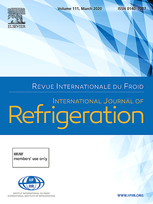
Summary
The seasonal performance has become increasingly important for residential heat pumps which occupy a majority of household power consumption. Thus, the heat pump system and its components are requested to be re-designed with reflecting the part load characteristics. Furthermore, actuators should be optimally operated for each test condition to maximize system efficiency. Among them, indoor and outdoor fan speeds are the only variable that can be independently controlled and have the widest operation range. Therefore, in this study, a non-iterative heat pump simulation model is presented to precisely predict the optimum air flow rate for each part load condition by introducing the modified effectiveness. The non-dimensional correlation is developed for the modified effectiveness and semi-empirical efficiency models are utilized for estimating the compressor performance. Validating experiments identify that the model can predict the optimum air flow rate for various part load conditions within an error of 10%. Consequently, the optimum air flow rate can be instantly obtained for various operating conditions.
Available documents
Format PDF
Pages: 51-60
Available
Public price
20 €
Member price*
Free
* Best rate depending on membership category (see the detailed benefits of individual and corporate memberships).
Details
- Original title: Predictive optimization of the air flow rate for a residential heat pump in seasonal performance conditions.
- Record ID : 30029110
- Languages: English
- Subject: Technology
- Source: International Journal of Refrigeration - Revue Internationale du Froid - vol. 131
- Publication date: 2021/11
- DOI: http://dx.doi.org/10.1016/j.ijrefrig.2021.07.008
- Document available for consultation in the library of the IIR headquarters only.
Links
See other articles in this issue (95)
See the source
Indexing
-
Contemporary and unbalanced loads in buildings:...
- Author(s) : CRESPI G., ABBÀ I., CORGNATI S. P., PRENDIN L., BABUIN M.
- Date : 2022/02
- Languages : English
- Source: REHVA Journal - vol. 59 - n. 1
- Formats : PDF
View record
-
Seasonal performance assessment of sanitary hot...
- Author(s) : TAMMARO M., MONTAGUD C., CORBERÁN J. M., et al.
- Date : 2017/02
- Languages : English
- Source: International Journal of Refrigeration - Revue Internationale du Froid - vol. 74
- Formats : PDF
View record
-
The environmental performance of nationwide hea...
- Author(s) : VERING C., ZIBUNAS C., TESSAREK F., ROMBERG H., HÖGES C., ASSEN N. von der, MÜLLER D.
- Date : 2025/08
- Languages : English
- Source: Cell Reports Sustainability - vol. 2
- Formats : PDF
View record
-
Pompy ciepla w ogrzewaniu budynkow mieszkalnych...
- Author(s) : JASIUKIEWICZ P.
- Date : 2008/04
- Languages : Polish
- Source: Technika Chlodnicza i Klimatyzacyjna - vol. 15 - n. 4
- Formats : PDF
View record
-
In-situ method for air-to-air heat pump seasona...
- Author(s) : TRAN C. T., NOËL D., RIVIÈRE P., ARZANO C., MARCHIO D.
- Date : 2021/07
- Languages : English
- Source: International Journal of Refrigeration - Revue Internationale du Froid - vol. 127
- Formats : PDF
View record
